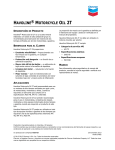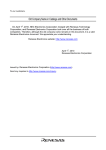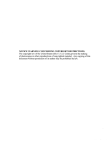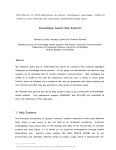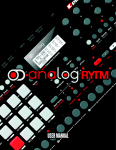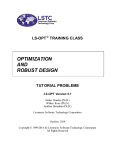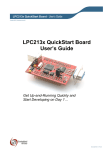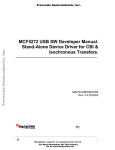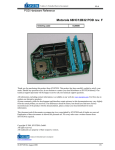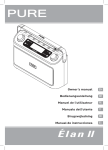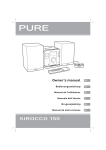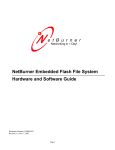Download Prototype Software for Automatic Generation of On
Transcript
Prototype Software for Automatic Generation of On-line Control Programs for Discrete Manufacturing Processes Gregg Ekberg and Bruce H. Krogh CMU-RI-TR-87- 3 Flexible Assembly Laboratory The Robotics Institute Carnegie Mellon University Pittsburgh, Pennsylvania 15213 February 1987 Copyright @ 1987 Carnegie Mellon University This work has been supported in part by General Motors Corporation, North American Philips Corporation, and the National Science Foundation under research grant DMC-8451493. 1 Table of Contents 1 Introduction 2 Control of an Automatic Conveyor 3 DBBUILD 4 PROGGEN 4.1 Description 4.2 Analysis 5 Additional Utilities 5.1 TIMERS 5.2 COUNTERS 5.3 EXTERNAL FUNCTIONS 6 Conclusion I. Sensors, Actuators, Resources, and Operations for Conveyor Example II. DBBUILD User’s Manual 11.1 Introduction 11.2 Structure 11.2.1 Operation Records 11.2.2 Resource Records 11.2.3 Actuator Records 11.2.4 Sensor Records 11.3 Menus 11.3.1 Operation Menu 11.3.2 Resource Menu 11.3.3 Actuator Menu 11.3.4 Sensor Menu 1 3 4 7 7 14 17 17 17 18 18 19 22 22 22 22 24 25 26 26 27 29 30 31 .. 11 List of Figures Figure 1: Modular paint shop conveyor system Figure 2: Detail of conveyor stops and chain Figure 3: Petri net model of conveyor control logic for the base-coat booth Figure 4: Database structures and pointers: operation records Figure 6: Database structures and pointers: resource records Figure 6: Database structures and pointers: sensor records Figure 7: Database structures and pointers: actuator records Figure 8: PROGGEN Flow Chart 5 5 6 8 9 10 ' 11 12 Abstract This report describes prototype software for automatically generating control programs for discrete manufacturing processes from a high-level description of the system control logic. The control logic is synthesized from a specification of the physical resource states required for each operation in the process. The software described in this report allows the user to specify - interactively the operation sequencing logic and the actuators and sensors for each stage of the process. This information is then used to automatically generate code for on-line control computers. The current implementation supports binary sensor and actuator signals. The methodology is illustrated for the automatic generation of instruction list (IL) code t o control a conveyor system in an existing robotic assembly plant. 1 1 Introduction The writing and debugging of computer programs for sequential control accounts for a major component of the cost in implementing automated manufacturing systems. It is also time consuming and expensive to modify existing control programs. This report describes prototype software for reducing the time and cost involved in developing discrete control programs by automatically generating executable computer code from a high-level description of the system control logic. With this software the manufacturing engineer can specify the control logic in terms of the physical devices and operations from which the computer generates the programs for real-time control. The prototype software described in this report is comprised of two programs: DBBUILD and DBBUILD (Data Base BUILDer) is an interactive program used to build and PROGGEN. modify a d a t a base containing the system control description in terms of its physical devices and operations. PROGGEN (PROGram GENerator), executed from within DBBUILD, generates source code for the on-line control computer. Normally, a skilled programmer performs the task of developing the controller program (usually in the Ladder Diagram Language) from the system designer’s description of a discrete manufacturing system. Several problems can arise from the transfer of information t o the programmer and the manual encoding of the system control logic. This is due to several factors, including: 0 0 0 the designer’s description of the system can be misinterpreted; the programmer’s implementation may be inflexibly structured around the specific sensor/actuator realization, whereas the design engineer will maintain flexibility t o meet changes in the operation of the system. the functional description of the system operation is not clearly reflected in the lowlevel control program. These factors make it difficult to debug the control program or make changes in the sequencing of operations. Future modifications may be made difficult because the programmer did not anticipate possible changes in operation sequencing. The manufacturing engineer thinks more about how the sequencing of operations may affect future operating conditions. 2 T h e objective for developing the software described in this report is to eliminate the need for manually encoding the discrete control logic for manufacturing systems. This task is accomplished by the computer, allowing the system designer to specify and modify the control program using a high-level functional representation of the system. To maintain a systematic approach of generating system control programs, the code is generated for one operation at a time, using physical states of resources as enabling conditions. It is not necessary for the user to specify when to enable and disable the operation actuators; this task is performed automatically by PROGGEN. Control of a discrete manufacturing system involves the coordination of multiple resources in a sequence of discrete operations. T h e initiation of each operation depends on the states of physical parts and devices (resources) within the system. A resource is any component within the manufacturing system that is involved in the system’s operation: robots, fixtures, raw materials, controllers, etc. Following the execution of an operation, the states of the resources involved in the operation are changed; sensors are used to monitor changes the resource states. We use Petri nets (PN) to model the discrete decision and control of a manufacturing system. Previous research has shown that P N models are effective for modeling the evolution of the state transitions in discrete systems [l]. P N s contain transitions, representing operations or events; places, representing conditions or states in the process; and directed arcs connecting the places and transitions. In the graphical representation of PNs, transitions are represented by vertical bars and places are represented by circles. T h e conditions enabling an operation are the resource states associated with the operations input transition. Upon completion of the operation the resources will be in the states associated within the output transition. Recently, a systematic methodology was developed for synthesizing P N models of discrete manufacturing systems [2, 3, 41. As presented by Beck [2], systematic approaches to developing the manufacturing system control logic can be synthesized from activity cycles for each resource. T h e resource activity cycles are developed, individually and then joined at common operations to synthesize the complete system control logic. We use this approach to define information that is entered into the database using DBBUILD. T h e report is organized as follows. In section 2 we present an example of an automated conveyor system in an automobile paint shop which we use throughout the report to illustrate 3 the functions of DBBUILD and PROGGEN. In section 3 we describe the structure and use of DBBUILD, and in section 4 we describe PROGGEN and discuss its performance in terms of the generated controller code. T h e performance criteria is based on correctness and gains or losses in efficiency compared to code developed manually by a programmer. In section 5 we propose methods for incorporating additional utilities such as timers, counters, and external functions into DBBUILD and PROGGEN. T h e structure of the database built by DBBUILD corresponds to a P N model of the system. Thus, P N techniques can be applied to determine if deadlocks or inconsistencies exist in the control logic. Current research into the application of P N theory for automatic evaluation and diagnosis of programming errors is discussed in the concluding section. 2 Control of an Automatic Conveyor In this section we illustrate the Petri net methodology for an automatic conveyor system at the General Motors Truck & Bus Assembly Plant in Baltimore, MD. This example is used as an illustration throughout the remainder of the report. The conveyor system, illustrated in figure 1, indexes vans through a painting module consisting of a preparation booth, a base-coat booth, a clear-coat booth, and an observation booth. The preparation booth is used for final preparation of the vans before painting. Coats of pigment and resin are applied in the base-coat booth followed by the application of a coat of clear resin in the clear-coat booth. (All painting is performed by robots.) T h e purpose of the observation booth is to allow sufficient flash time so that the majority of the solvents can vaporize before the vans enter an oven for baking. T h e conveyor system is presently controlled by an Allen-Bradley PLG2/30. All sensor signals (from limit switches) and actuator commands (to pushers and mechanical stops) are binary. The controller coordinates the motion of the vans and the opening and closing of the doors between the booths. T h e doors must be closed during painting and a van must not be released into the next booth before the booth is availabel. T h e conveyor chain, shown in figure 2, is a roller flight chain which allows a van to be held in place by mechanical stops while the chain, and other vans in the system, continue to move. Unpainted vans are held by a mechanical stop in the preparation booth and released when the base-coat booth becomes availabel. After entering the base-coat booth the van skid moves up to a set of grounding bars where the rear dog on the pusher catches the push plate on the skid (see figure 2). T h e van is then pushed into a secured painting position on the grounding bars. Prior 4 to initiating the base-coat painting cycle the booth doors are closed and the pusher is retracted to prevent the buildup of paint on the cylinder shaft. Following the completion of the base-coat painting cycle, the doors are opened and the van skid is pushed off the grounding bars by the front dog of the pusher if the clear-coat booth is availabel. This sequence of events is repeated in the clear-coat booth. When the van moves into the observation booth, mechanical stops hold it in place while the solvents vaporize. Using the P N methodology described in the introduction, a P N model of this system was synthesized from single resource activity cycles for the van, conveyor chain, mechanical stops in the preparation and observation booths, doors, and pushers in the base-coat and clear-coat booths. T h e base-booth portion of the PN for the conveyor control logic is shown in figure 3. Descriptions of the resource states and operations for this part of the net are given in appendix I. T h e P N for the clear coat and observation booths are similar. 3 DBBUILD I DBBUILD is an interactive program written in the C programming language and is used to enter the system description into a d a t a base. T h e database is comprised of four major record types: 1) operations, containing information on input and output transitions, resource states, and actuators, 2 ) resources, containing information on the resource states and the sensor data required to define each state, 3) sensors, containing the address label of the sensor input port, and 4 ) actuators, containing the address label for the actuator output port. Diagrams of the four record types are shown in figures 4 through 7. DBBUILD consists of procedures to create and modify these records. Each record is built using doubly linked lists established through pointers to structures. For example, and as shown in figure 4, within the operation structure there are pointers to the next and previous operations, pointers to a list of the input transitions, pointers to a list of the output transitions, and pointers to a list of the associated actuators. In turn these structures have pointers to structures that contain information on the resource states and the actuators. Attached to each each input and output transition of an operation are the resource states that are required to enable the transition. While building an operation the user does not need to specify the sensors required to define the resource state. This information can be added at some other time as a function of the resource state. 5 Figure 1: Modular paint shop conveyor system Figure 2: Detail of conveyor stops and chain 6 L Figure 3: Petri net model of conveyor control logic for the base-coat booth 7 DBBUILD protects against entering incorrect conditions for identifying a resource state by accepting a sensor pointer only if the sensor has been entered in the d a t a base. Similarly, an actuator cannot be referenced in an operation record unless it has been entered in the actuator database. Additionally, DBBUILD will inform the user if a state attached to an operation transition is, or is not, present in the resource d a t a base. These checks help prevent confusion for the user and prevents errors from occurring in the controller code t h a t is generated by PROGGEN. More information on DBBUILD is provided in the User’s Manual in appendix 11. 4 PROGGEN 4.1 Description PROGGEN is written in the C programming language and is used to generate Instruction List (IL) code from a d a t a base constructed using DBBUILD. Instruction List programs are executed sequentially and repeatedly by a programmable logic controller to generate and maintain the correct outputs to the system. T h e instructions used in this version of PROGGEN are per the International Electrotechnical Commission SC65A/WG6 Standard for Programmable Controllers [5]. T h e current version of PROGGEN supports the generation of a control program for a simple discrete process. It does not yet support operations requiring timers, counters, arithmetic functions, or logical comparison. Possible methods for incorporating these functions are described in section 5. T h e basic logical flow of PROGGEN is shown in Figure 8. It looks at each operation separately, generating code to check the required resource states. Then, conditional on these states, code is generated to enable the desired actuator outputs. Setting (latching) the resultant resource states is based on the sensors associated with the resultant resource states, within a transition, and is performed to maintain the system state as defined in the Petri net. T h e instructions within IL are used to develop conditional branches based on the system state. For example, IF AND [(limit switch 1 (LSl) is activated limit switch 2 (LS2) is not) OR (limit switch 1 is activated AND limit switch 3 (LS3) is activated)] THEN turn on solenoid 1 (Si) 8 OPERATIONS DESCRIPTION NO OF INPUT TRANS OF OUTPUT TRANS PREVIOUS POINTER TO ASSOCIATED ACTUATORS POINTER TO ONE OF 'THE JWPUT OR OUTPUT TRANSITIONS NEXT DESCRI PTION NO OF INPUT OR DESRIPTlON PCTUATOR WINTER TO EACH OF THE RESOURCE STATES DESRIPTION RESOURCE NAME 4 4 NEXT 4 PREVIOUS DESRIPTION RESOURCE NAME Figure 4: Database structures and pointers: operation records 9 RESOURCES POINTER TO BEG1NNI NG RESOURCE NAME> NEXT RESOURCE DESCRIPTION NO OF STATES I OESCRlPTION NO OF DIFFERENT SETS OF SENSORS USED DESCRIPTION NO OF SENSORS IN PRnIOm PREY IO16 POINTER TO LIST OF THE REQUIRED DESCR IPTION SENSOR NAME 7.4 PREVIOUS Figure 5: Database structures and pointers: resource records 10 SENSORS D~RIPTION UO OF RESIURCES IN WHICH IT IS USED TYPE OF SENSOR WIRE NUMBER Figure 6: PREVIOUS Database structures and pointers: sensor records 11 POINTER TO BEGINNING OF ACTUATOR LIST ACTUATOR NAME OESCRI PTlON NO OF OPERATIONS IN WHICH IT IS USED TYPE OF OUTPUT WIRE NUMBER NEXTACTUATOR A c PREYIOUS # 4 Figure 7 : Database structures and pointers: actuator records 12 t tw) )sF - 1 WITH THE ‘AND’ IELSTRUCTIW FROn NEXT PAGE Figure 8: PROGGEN Flow Chart (Continued on next page) 13 YES SENSORSAssocIAfED WITH THIS RESOORESA3SOCIATED WITH THIS Figure FLOW (continued) 14 In IL would be represented as follows: LD ANDN AND LS 1 LS2 LS1 LS3) ST si OR ( To simply enable the actuator when the input resource state conditions are satisfied is not sufficient. Actuators vary in types; some are required to remain enabled for the duration of the operation while others are required to remain enabled until another motion of the same actuator is needed. Enabling the actuator output for the duration of an operation is established by the fact that the input states to the operation remain true until an output transition becomes true, as defined by the associated resource state sensors, and new states are defined. Other types of actuators must remain rigid even after its motion is complete. For example, the doors between the booths in the conveyor example must be held open after the door open limit switch has been activated. This prevents the doors from drifting shut and possibly making contact with the van, causing a paint defect. T h e task of maintaining the output to the specified actuator is performed automatically by PROGGEN. If a n actuator has in its description more than one motion, PROGGEN will first reset all outputs to the actuators then set the output for the desired motion. Therefore for the case described above, the operation t h a t opens the door will set (latch) the output to the door open solenoid. In the operation that the door is to be closed, the output to the door open solenoid will be reset (unlatch) and the output to the door close solenoid will be set. This method will also work for actuators with more than one motion, not just two-way actuators. 4.2 Analysis When sensors are not associated with a resource state, feedback words are needed to maintain the control logic. Feedback words are words that are stored in memory and are used to remember if a resource is in a given state. For example, the state of the base booth in the conveyor example is not explicitly defined by sensors. Therefore when its state is changed it is set with the " S " instruction (latched) and a location within its memory structure in DBBUILD is 15 updated with its latched state. If an old state is still latched when a new state is to be latched, PROGGEN will unlatch the old state and latch the new state. This operation follows from the fact t h a t a resource cannot be in more than one state at any given time. Creating feedback words only for those states that are not defined by sensors does not provide sufficient information on the system state to enable the proper outputs. In the current version of PROGGEN, feedback words are created for all resource states. Storing all resource states provides the required information for proper sequencing, but leads to inefficient IL code. To clarify the need for the storage of all resource state information, consider operations 2 and 5 in the conveyor example (move the van into the painting position and move the van out of the painting position). T h e resulting IL code for only remembering those states that are not defined by sensors is as follows: (Note: enabling conditions are now the sensors for those resource states that are defined by sensors:) OPERATION 2 OPERATION 5 (*Enabling*) (*Enabling*) LD AND LD S ‘BLSI BPLS 1 BPEXT AND AND S (*Result*) LD AND R BLS2 BPLS2 BPEXT (*Result*) LD AND R R 6 S (*Result*) LD AND R S BLSl BPLS2 BPEXT El CBC BPLS 1 BLS2 BPEXT BLS3 BPLS2 BBF BPEXT BBC CBF (*Result*) LD AND R S BLS2 BPLS2 BPEXT E2 We see t h a t when both BLS2 and BPLS2 are high, following completion of operation 2, E2 from operation 5 will be set, which is not what we wanted. To prevent this type of sequencing problem all resource states, whether defined by sensors or not, are used as feedback words. This change produces the correct code as shown below. 16 OPERATION 2 OPERATION 5 (*Enabling*) LD vi AND BP 1 ST BPEXI' (*Enabling*) LD CBC AND BP3 v3 AND ST BPMT (*Result*> v1 LD AND BP 1 AND BPL52 AND BLSl R vi R BP1 S El (*Result*) LD CBC AND BP3 AND v3 BPLS2 AND BLS2 AND R CBC R BP3 S E2 (*Result*> LD vi AND BP 1 AND BLS2 AND BPLS2 R v1 (*Result*> LD CBC AND BP3 AND v3 AND BPLS2 R CBC R BP3 S B3C S S v2 BP2 S S v4 BP4 T h e inefficiency of using this method to maintain correct sequencing stems from the fact that many times feedback words are generated which are not required to maintain correctness. For example, the state V1 (van entered base booth) is explicitly defined by BLS1. At no other time is BLSl activated, nor will the state V1 exist if BLSl is not activated. Using the S (set) instruction is considered poor programming style primarily because if a power failure occurs the set or latched states will remain high, thus resetting the system logic becomes very difficult. Also, with set instructions there is possibility of logic errors by forgetting to reset the word; however, latched words. PROGGEN removes this problem because i t maintains the states of the 17 5 Additional Utilities T h e prototype versions of DBBUILD and PROGGEN presented in this report have been developed to support automatic generation of controller code for systems with binary sensors and actuators. Further work is required to implement the required software to support timers, counters, external functions (add, subtract, logical comparison, etc.), and non-binary inputs and outputs. Some ideas for possible implementations of these control structures are presented in this section. 5.1 TIMERS Timers are often used to monitor the sequencing of a system. A timer can be viewed as a function within an operation t h a t is initiated when the operation is enabled. W e propose to have operations t h a t can be specified as timed operations for which DBBUILD will prompt the user for the p r e s e t timer duration. During controller code compilation PROGGEN will allocate a timer to t h a t operation internally and will attach to the variable state TIMER the address of the timer completed status word (bit 15 of the timer address (51 ). T h e use of the variable TIMER allows the user to specify those output transitions that are dependent on the timer. If the operation reaches an acceptable output transition the timer is automatically reset. 5.2 COUNTERS Counters are often required to remember how many times an operation has been executed and based on the accumulated value of the counter, initiate another operation. For example, in an automated paint shop the paint gun requires cleaning if the same color has been used N times (If a different color is used a purge operation is performed which includes cleaning the gun). We therefore want to count the number of consecutive times the same color has been used. It is proposed to view the counter as a type of actuator. The counter name would act as the label to the counter address within the controller code. The state of the counter is then defined by two associated feedback words representing counting and finished states. These states can be defined by the counter address bits 16 and 15 respectively (51. To allow the user to use the counter feedback words in other operations we define feedback words label.cnt and label.done as follows: for countervalue < N for countervalue = N for countervalue > N 1abel.cnt = 1; 1abel.done = 0 1abel.cnt = 0; 1abel.done = 1 reset countervalue; countervalue = 1; 18 where label is the counter name as defined by the system designer. For example, samecolor. cnt would be the variable attached to bit 16 of the samecolor counter. 5.3 EXTERNAL FUNCTIONS External functions are required to perform a series of operations t h a t do not belong at the level of the system state description. For example, comparing the value of a sensor to some set point. I t is proposed to have the user define an external function label in the associated actuator list in an operation and it will remain his responsibility to generate code for t h a t label. Simple routines are easy to write in the Structured Text Language [5] and are easily accessible by the Instruction List code using the JMP instruction. All variables will be the same names as those used in the system description level. 6 Conclusion This report presents some initial work in the area of automatic programming of programmable controllers from high level descriptions. T h e software developed illustrates the ability to interpret a d a t a base t h a t contains the system operation information, and from it generate executable controller code. Additional work is required in the area of simulation and analysis of the generated control logic. T h e d a t a base generated by DBBUILD is structured identically to the information contained within a P N model of the system. This structure allows existing Petri net theories to be used to determine if deadlocks are present. T h e program that performs the net analysis may be a simulation program t h a t can simulate the nets operation given an initial marking, or placing of the tokens. Ultimately to allow the generated code to be used in a production environment, an interface such as Ladder Diagram needs to be presented to the technician for use in on-line debugging of the system. One of the purposes of the IEC Language Specification is to provide consistency between controller codes. This consistency should allow the development of linking programs t h a t can change the controller code from etc, and back again. IL to Structured Function Chart [5] to executable code, 19 I. Sensors, Actuators, Resources, and Operations for Conveyor Example T h e following two lists show the sensors and actuators used in the conveyor example: SENSORS: PLSl BLSl BLSS BLS3 CLSl PREP BOOTH LIMIT SWITCH 1 BASE BOOTH LIMIT SWITCH 1 BASE BOOTH LIMIT SWITCH 2 BASE BOOTH L M T SWITCH 3 CLEAR BOOTH LIMIT SWITCH 1 BPLSl BPLS2 BASE PUSHER LIMIT SWITCH 1 BASE PUSHER LIMIT SWITCH 2 BLDO BRDO BLDC BRDC BASE LEFT DOOR OPEN LIMIT SWITCH BASE RIGHT DOOR OPEN LIMIT SWITCH BASE LEFT DOOR CLOSED LIMIT SWITCH BASE RIGHT DOOR CLOSED L M T SWITCH ACTUATORS: PBSD PBSU BPEX BPRET RBDO LBDO RBDC LBDC PREP BOOTH STOP DOWN PREP BOOTH STOP UP BASE PUSHER EXTEND BASE PUSHER RETRACT RIGHT BASE DOOR OPEN LEFT BASE DOOR OPEN RIGHT BASE DOOR OPEN LEFT BASE DOOR CLOSE T h e following lists provide a brief description of the resource states and operations modeled by the P N in figure 3. VAN RESOURCE CYCLE: VO = Van at prep booth stop. V1 = Van arrived in base booth. V2 = Van in base booth painting position. V3 = Base coat applied to van. V4 = Van at base booth doors. V5 = Van arrived in clear booth. VE1= Failed to move into paint position VE2= Failed to move off grounding bars SENSORS REQUIRED: PLSl BLSl BLS2 NONE BLSS CLSl BPLS2 and BLSl BPLS2 and BLS2 20 BASE BOOTH PUSHER RESOURCE CYCLE: BP1 =Base pusher retracted and waiting for van to arrive BP2 =Base pusher extended with van in the back dog (thus the van is in the painting position). BP3 =Base pusher retracted while the van is in the painting position. BP4 =Base pusher extended with van in the front dog (thus the van is pushed past the painting position). BASE BOOTH DOORS RESOURCE CYCLE: BDOl = Opened for van to pass through B D 0 2 = Base doors open and van passed BDCl = Base doors closed for painting BDC2 = Base doors closed, painting complete BDOE = Error base door open (the doors did not open) BDCE = Error base doors close (the doors did not close) BASE BOOTH RESOURCE CYCLE: BBF = Base booth clear (empty) and waiting for the next van. CONVEYOR RESOURCE CYCLE: CS = Conveyor stopped. SENSORS REQUIRED: BPLSl BPLS2 BPLS 1 BPLS2 SENSORS REQUIRED: BLDO and BRDO BLDO, BRDO, CLSl BLDC and BRDC BLDC and BRDC BLS3 and N O T BLDO BLS2 and N O T BLDC and N O T BRDC SENSORS REQUIRED: NONE SENSORS REQUIRED: NONE 21 OPERATIONS: ACTUATORS REQUIRED OP1 =Drop stop in prep booth and allow van to move into base booth. O P 2 =Put van into base booth painting position by extending base pusher. OP3 =Retract base pusher. O P 4 =Apply base coat to van. OP5 =Extend base pusher to push van past painting position. OP6 =Open base booth doors. OP7 =Retract base pusher to accept new van arriving in base booth. OP8 =Stop conveyor to prevent van from hitting base doors. OPS=Move van from base doors to clear booth pusher. OPlO=Close base booth doors. PBSD OPEl=Manual reset of base pusher and van in paint position OPEB=Manual reset of base pusher and van off grounding bars OPE3=Manually open of base doors and restart conveyor. OPE4=Manually close base doors NONE NONE NONE BPEXT BPRET NONE BPRET RBDO and LBDO BPRET NONE NONE RBDC and LBDC 22 II. DBBUILD User's Manual II.1 Introduction DBBUILD an interactive program used to obtain and store information concerning a discrete manufacturing system' . The structure of DBBUILD emulates a Petri net model to simplify analysis of the system logic using existing Petri net theories. The purpose of this appendix is to familiarize the user with DBBUILD's structures and menues. DBBUILD prompts the user for all information that is required and therefore an experienced programmer would feel quite comfortable using DBBUILD without first reading this manual. However, DBBUILD will query for information that may seem irrelevant; this manual tries to explain the need for these queries. II.2 Structure The d a t a base is comprised of four major record types: 1. operations, containing information on input and output transitions, resource states, and actuators; 2. resources, containing information on the resource states and the sensors data required to define each state; 3. sensors, containing the address label of the sensor input port; and 4. actuators, containing the address label for the actuator output port. Schematics of the records are shown in figures 4 through 7. The topics discussed in this part of the manual are for use by those who have an understanding of a structured language. Comprehension of the material is not required t o use DBBUILD. II.2.1 Operation Records The following is the top level structure in the operation record: typedef s t r u c t o p e r a t i o n type < char name [NAME SIZE] ; char d e s c [DESC-SIZE1 ; int num i n op; n u m-o u t-op; i nt i nt num assoc act; st r u c t op e F a t i o n typ e st r u c t op e r a t ion-t - ype - o p e r a t i o n name defined by u s e r operation description holds t h e number of i n p u t t r a n s i t i o n s holds t h e number of o u t p u t t r a n s i t i o n s h o l d s number of a s s o c i a t e d a c t u a t o r s *next ; *prev; s t r u c t i n op *in-o p g t r ; p o i n t e r t o l i s t of i n p u t t r a n s i t i o n s s t r u c t o u t-op * o u t - o p g t r ; p o i n t e r t o l i s t of o u t p u t t r a n s i t i o n s 'The authors would like to thank Wayne Figurelle for developing the C code for DBBUILD. 23 struct act-list *assoc-actgtr; pointer to list of actuators affected by the operation T h e following structure contains information on the associated actuators < typedef struct act-list char char char char char name CNAME-SIZE1 ; structure name defined by DBBUILD desc [DESC SIZE]; not used act name [EAME SIZE]; name of the actuator ass& op name TNAME SIZE]; not used SIZET; the condition of the actuator act-c&d-[COND defined by user struct act list *next ; struct act-1 - ist *prev; - T h e following structure holds information on the input transitions typedef struct char char int name [NAME SIZE]; desc [DESC-SIZE] ; num-in-op-k ; etruct in op B truct i n o p - in-op C DBBUILD name of the transition not used number of resource states aSSOClated with the transition *next ; *prev; points to a list of the resource struct in-op-AND *in-op-ANDjtr; states associated with the transition The following structure holds information on the output transitions: typedef struct out op char char int struct struct C name TNAME SIZE] ; deSC CDESC-SIZE] ; num out-0 p-- m ; out o p out-o p *next; *prev; struct out-op-AND The following structure holds the input transition’s resource states; typedef struct in op AND char char char char struct struct C name- [NAME SIZE] ; structure name defined by DBBUILD desc [DESC-SIZE1 ; not used res name [iAME SIZE]; the resource name state name [N& -SIZE]; the resource state name *next ; in 0 p - m in-op-rn - *prev; 24 The following structure holds the output transition's resource states: struct out-op-AND char name [NAME SIZE]; char desc CDESC-SIZE1 ; char res name ChMl-SIZEl ; char state name [NAME-SIZE]; struct out 0; AND *next ; struct out-0 p-- m *prev; typedef i lI.2.2 Resource Records The following is the resource record and its components: Typedef struct resource-type i Char name [NAME SIZE] ; Char desc [DESC-SIZE] ; struct resourc; type *next; *prev; Struct resource-type int num-state; Struct state-type *stategtr; Name of the resource Description of the resource Holds the number of different states the resource has Points to the resource state structure The following structure contains information on the resource states: Typedef struct state type Char name[NAME SIZE]Char de 8 c [DESCISIZEI Char latched < Struct state type *next Struct statetype *prev Int num-OR The resource state structure Name of the state Description of the state Used for generating the XL code - struct OR-type *ORgtr Number of sensors used to determine the state Points to the series of sensors used to define state The following structure contains the name of the series of sensors used to define a specified resource state: Typedef struct OR-type Char name [NAME SIZE] Char desc CDESCISIZEI Struct OR type *next Struct ORtype *prev Int num-GD DBBUILD structure name not used Number of sensors in series 25 S t r u c t AND type *ANDgtr Pointer t o t h e sensors i n the series The f o l l o w i n g s t r u c t u r e c o n t a i n s t h e s e n s o r names f o r a s p e c i f i e d s e r i e s Typedef s t r u c t AND type C h a r name [NAME-SIZE1 C h a r deSC [DESC SIZE] S t r u c t AND t y p e *next S t r u c t m - t y p e *prev C h a r s e n s o r name [NAME SIZE] Char sensor-cond [CONDSIZEI - - - - Char assoc res nameCNAME SIZE] DBBUILD s t r u c t u r e name n o t used Sensor name The s t a t e of t h e s e n s o r a c t i v a t e d h o t activated n o t used II.2.3 Actuator Records The actuator record is defined as follows: Typedef s t r u c t a c t u a t o r Char name [NAME SIZE] Char desc CDESC-SIZE] S t r u c t motion s t r u c t - I n t wire num S t r u c t a z t u a t o r *next S t r u c t a c t u a t o r *prev I n t num-assoc-op S t r u c t assoc-op Actuator s t r u c t u r e Name of t h e a c t u a t o r Actuate s d e s c r i pt i o n Indicates different actuator/ mot i o n s Actual wire number Number of o p e r a t i o n i n which a c t u a t o r is used P o i n t s t o an o p e r a t i o n The f o l l o w i n g s t r u c t u r e holds information on t h e o p e r a t i o n s i n which t h e a c t u a t o r i s used: Typedef s t r u c t assoc-op Char Char Char Char name [NAME SIZE] de sc [DESC-S IZE] op n a m e C N k SIZE] a c t-l i s t [NAME- SIZE] - S t r u c t assoc op *next S t r u c t assoc-oD *Drev Name of t h e o p e r a t i o n N o t used 26 II.2.4 Sensor Records The sensor record is as follows: Typedef struct sensor type Char name [NAME-SIZE] Int wire num Char des; [DESC-SIZE] Int cond sensor name description of the sensor (optional) condition the sensor will b e In when actuated Struct sensor type *next struct sensor-t yp e *pr ev Int num-assoc-res Struct assoc-res *assoc-resgtr Number of resources for which this sensor is used Pointer to aSSOClated resources The following structure contains information on resource states in which the sensor is used: Typedef struct assoc res Char name [NAME SIZE]Char de sc [DESCSIZE] Char res name [hMl-SIZEl Char state name [NAME SIZE] struct ass& res *ne% - *prev Struct assoc-res DBBUILD structure name not Used Resource name State name II.3 Menus The menus used to prompt the user use terms used to describe elements of Petri nets. Most menu options are self explanatory; however, those options that are not will have a brief explanation following the menu listing. The top level menu, and therefore the first one you see, allows you to choose which record you want to investigate. This menu is as follows: S = For sensor data type R = For resource data type 0 = For operation data type = For actuator data type Q = To quit this program A Which type do you want to alter or look at? 27 II.3.1 Operation Menu If at the top level you decide to look at operations, the following menu will appear: I-INSERT new operation D-DELETE an operation F-FIND an operation or some i n f o about an operation A-INSERT a6soc. actuator for t h i s operation P-INSERT an o u t op cond OR header for t h i s operation C-INSERT an o u t op cond AND header for t h i s operation 0-INSERT an i n op cond OR header for t h i s operation H-INSERT an i n op cond AND header for t h i s operation L-LIST a l l of t h e names present Q-Quit, and look a t another data base ? - L i s t a l l of the commands a v a i l a b e l "P" will generate the structure for an output transition and name that transition TRANS-(n); where n is a number DBBUILD maintains. Once the transition has been named; DBBUILD will ask if there are any resource states that you want to attach to this transition. Upon entering a state DBBUILD will generate a structure to hold the state name. DBBUILD will name this structure STATE-(n) much in the same way it names the transitions. "C" can be used to add additional resource states to a n existing output transition. DBBUILD will first ask for t h output transition name (TRANS-1, TRANS-2, etc.) and then allow you to enter a resource state. "0"and "H" perform the same as "P" and "C" respectively, but are used for input transitions rather than output transitions. NOTE 1: T h e words "OR" and "AND" used in the menus refer to transitions and resource states associated with that operation respectively. OR is used for transitions because they represent the different enabling or resulting sets of resource states. AND is used for resource states within a transition because all of the resource states must be satisfied for that transition to be enabled. NOTE 2: T h e labels TRANS-(n) and STATE-(n) are used by DBBUILD to search through the record. 28 See struct in -op-OR and struct in -op-AND in section 3 of this manual for more information. *IF"will cause DBBUILD to prompt the user for an operation name and will then display the next menu containing new options. D-To A-To F-To 0-To N-To I-To G-To Q-To ?-To see t h e d e s c r i p t i o n of t h e o p e r a t i o n l i s t a l l of t h e o s s o c . a c t u a t o r s w i t h t h i s o p e r a t i o n f i n d i n f o about ossoc. a c t u a t o r s w i t h t h i s o p e r a t i o n l i s t a l l of t h e o u t ops a s s o c . w i t h t h i s o p e r a t i o n g e t i n f o about t h e o u t ope a s s o c . w i t h t h i s o p e r a t i o n l i s t a l l of t h e i n ops a s s o c . w i t h t h i s o p e r a t i o n l i s t a l l about t h e i n ops a s s o c . w i t h t h i s o p e r a t i o n q u i t looking a t t h i s o p e r a t i o n see t h e s e Commands "0"will list the names of this operations output transistions (TRANS-1, TRANS-2, etc.). "N" will cause DBBUILD to ask for the output transition name and then present the resource states associated with t h a t transition. "I" and "G"will perform the same tasks as "0"and "N" respectively except they are used for input transitions. T h e following menus are presented when the "Nu and "G" options are chosen from the previous menu: D-To see t h e d e s c r i p t i o n of t h e o u t-op L-To l i s t a11 of t h e ANDs p r e s e n t R-To see t h e r e s o u r c e name and t h e s t a t e name of an Q-You are done looking a t t h i s o u t op ?-To see t h e s e commands - AM) D-To s e e t h e d e s c r i p t i o n of t h e in-op L-To l i s t a l l of t h e ANDs p r e s e n t €2-To see t h e r e s o u r c e name and t h e s t a t e name of t h e AND Q-You a r e done looking a t t h i s ?-To s e e t h e s e Commands T h e following menu is presented when the "F" option is used in the previous menu: D-To s e e t h e deSCriptiOn of t h e assoc act C-To see t h e c o n d i t i o n t h e s e n s o r w i l i be i n a f t e r t h e op 29 L-to list all info about the assoc. actuator f o r this op Q-You are done lookinga t this assoc act ?to see these commands - II.3.2 Resource Menu If from the top level you decide to work on the resource record, the following menu will be presented: I-INSERT new resource D-DELETE a resource F-FIND a resource or some info about a resource L-LIST the name and descriptions of the resources present 6-Insert a STATE to a resource E-ELIMINATE a state from a resource 0-ADD a new SERIES of SENSORS to a given state A-ADD a SENSOR to a given series of a given state T-TRASH (delete) a SERIES of SENSORS from a given state W-Delete a SENSOR to a given series of a given state Q-Quit, and look at another data base ?-List all of the commands availabel NOTE: As a resource cycles (or is cycled) through the systems operations, its state will change. These states may or may not be defined by sensors, and in addition some states may be defined by more than one set of sensors. For example, some arbitrary state may be defined by sensors 1 and 2 or by sensors 3 and 4. DBBUILD's terms for these sets of sensors is SERIES; i.e. sensors 1 and 2 would be listed in SERIES-1 and sensors 3 and 4 would be listed in SERIES-2. DBBUILD uses the word SERIES-(n) to label the structure that contains the pointer to each of the sensors. See struct OR-type SENSOR-(n) AND-type If the in section 3 of this manual. Additionally DBBUILD uses as the name of the structure that holds the actual sensor name. See struct in section 3 of this manual. "F" option was chosen to find information about a resource, the following menu will appear: see the description of the state get info about a particular state list all of the states assoc. with this resource QUIT looking at this resource ?-to see these commands D-To S-To L-to Q-To 30 If at this level "S" is requested the following menu will appear: D-To see t h e d e s c r i p t i o n of t h e s t a t e L-To l i s t t h e SERIES of SENSORS assoc w i t h t h i s s t a t e 0-To see i n f o about a p a r t i c u l a r SERIES Q-You a r e done looking a t t h i s s t a t e ?-To s e e t h e s e commands If the "0" option is chosen the following menu will appear: L-To l i s t SENSORS a s s o c w i t h t h i s SERIES S-To l i s t a l l of t h e s e n s o r names under t h i s SERIES and t h e i r c o n d i t i o n s A-To see i n f o about a p a r t i c u l a r a s s o c i a t e d s e n s o r Q-You a r e done looking a t t h i s SERIES ?-To s e e t h e s e commands If at this level the "A" option is used DBBUILD will ask for the sensor name, SENSOR -1, SENSORS,etc. This version of DBBUILD does not contain additional information on sensors beyond what the "S" option provides. II.3.3 Actuator M e n u If at the top level you requested to enter the actuator record the following menu would appear: I INSERT new a c t u a t o r D~DELETE an a c t u a t o r F-FIND an a c t u a t o r or some i n f o about an a c t u a t o r L-LIST all of t h e names p r e s e n t Q - Q u i t , and look a t another data base ? - L i s t a l l of t h e Commands a v a i l a b e l T h e find command invokes the following menu: D-To see t h e d e s c r i p t i o n of t h e a c t u a t o r S-Get I n f o about a p a r t i c u l a r a s s o c op M-to l i s t a l l of t h e motions t h i s a c t u a t o r has L-To l i s t a l l of t h e a s s o c op w i t h t h i s a c t u a t o r Q-To QUIT looking a t t h i s a c t u a t o r ?-to s e e t h e s e COnIUiandS 31 II.3.4 Sensor Menu If at the top level you entered the sensor record, the following menu would appear: I-INSERT new sensor D-DELETE a sensor F-FIND a sensor L-LIST all of the sensors present W-Change the WIRE number assoc with a sensor Q-To quit and look at another data base ?-List all of the comands availabel The find option will cause the following menu to appear: D-To see DESCRIPTION of the L-To LIST all of the states W-To see the WIRE number of Q-When you are done looking ?-List these commands sensor that this sensor is used to define this sensor at this particular sensor 32 References 1. J.L. Peterson, Petri Net Theory and the Modeling of Systems, Prentice-Hall, Inc., Englewood Cliffs, NJ., 1981. 2. C.L. Beck, “Modeling and Simulation of Flexible Control Structures for Automated Manufacturing Systems”, Tech. report, Robotics Institute, Carnegie Mellon University, 1985. 3. C.L. Beck and B.H. Krogh, “Models for Simulation and Discrete Control of Manufacturing Systems”, IEEE International Confetence on Robotics and Automation, San Francisco, April 1986. 4. B.H. Krogh and C.L. Beck, “Synthesis of Place/Transitions Nets for Simulation and Control of Manufacturing Systems”, 4th IFAC/IFRS Symposium Large Scale Systems, International Federation of Automatic Control, Zurich, August 1986. 5. International Electrotechnical Commission, Standard for Rogrammable Controllers, Part 8: Rogramming Languages, 1982, Technical Committee 65: Industrial Process Measurement and Control




































